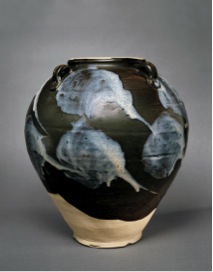The Censor’s Jar
An unusual account of tea was once written by a high court official during the eighth century. The report described the tea used in the offices of the Censorate, one the most powerful and feared agencies of the Tang imperial government.
The Censor’s Jar —The Censorate is comprised of three Bureaus: Headquarters Bureau, its personnel are called Attendant Censors; Palace Bureau, its personnel are called Palace Censors; and Investigation Bureau, its personnel are called Investigation Censors. The Investigation Bureau is located to the south. At the beginning of the Huichang reign period, the Investigation Bureau was renovated by the Investigating Censor Zheng Lu. The Investigation Hall of the Ministry of Rites is called the Hall of Pines, for to its south there are ancient pines. The Investigation Hall of the Ministry of Justice is called the Hall of Nightmares, for being held there causes many bad dreams. The Investigation Hall of the Ministry of War is responsible for the tea for the Bureaus. The tea must be the finest from the markets of Shu. It is stored in a ceramic vessel to protect it from heat and moisture. A censor personally oversees its care. Therefore, it is called the Censor’s Tea Jar.
御史瓶. 御史三院. 一曰臺院. 其僚曰侍御史. 二曰殿院. 其僚曰殿中侍御史. 三曰察院. 其僚曰監察御史. 察院㕔居南. 㑹昌初. 監察御史鄭路所葺. 禮祭廳謂之松廳. 南有古松也. 刑察廳謂之魘廳. 寢於此多魘. 兵察廳常主院中茶. 茶必市蜀之佳者. 貯於陶噐. 以防暑濕. 御史躬親監啟. 故謂之御史茶瓶.

New York
The Yushi ping 御史瓶 or Censor’s Jar was an entry in Record of the Censorate, a twelve-volume work that described the Tang imperial investigative organization known as the Censorate. The study was written by Han Wan 韓琬 (active 710–741), a Palace Censor who revealed the inner workings of the Censorate through nearly a century of its history. A direct witness to the inner workings of the agency, Han Wan detailed the matters of the Bureau through its registers, records, and biographies, including the establishment of the intelligence service, its sources and development, and its handling of official affairs and conduct.
According to Han Wan, tea was so essential to the daily operations of the Censorate that a ministry office was charged with its procurement and no less a senior officer than an imperial censor was charged with managing its storage. The quality of the tea was described as necessarily the best leaf from Shu, its most ancient source in Sichuan. Such was the importance of tea that its very repository was named yushi chaping 御史茶瓶, the Censor’s Tea Jar.
Han Wan was a native of Nanyang, Dengzhou in present Henan. While it was unclear from his Record as to whether or not he was a tea drinker, Han Wan appreciated the herb and its use by the Censorate to make exceptional note of it in his historical account. Moreover, subsequent records such as the Record of Things Heard and Seen testify to the informed interest in tea by later members of the Censorate, including the agency leaders Vice Censor-in-Chief Feng Yan 封演 (js 756) and the Censor-in-Chief Li Jiqing 李季卿 (709–767). Han Wan’s record of the Censor’s Jar was but one of a number of expressions of the utility and esteem of tea among the highest eschelons of the Tang imperial administration, especially northern elites.
Figure
A Large Blue-Splashed Brown-Glazed Stoneware Jar
Tang Dynasty, 8th – 9th Century
Height 16 inches (40.6 cm.)
J. J. Lally & Company
Oriental Art
New York, New York
Notes
Huichang 㑹昌 reign period (841–847).
Zheng Lu: 鄭路 (active ca. 841–847), an Erudite of the Court of Imperial Sacrifices and an Investigating Censor.
Record of the Censorate: Yushi taiji 御史臺記, after 741.
Record of Things Heard and Seen: Fengshi wenjian ji 封氏聞見記, ca. 772.
Sources
Tang yulin 唐語林 (Forest of Discussions of the Tang). Wang Dang 王讜 (active 1089), juan 8, pp. 7a-7b. SKQS.
Yinhua lu因話錄 (Tales of Retribution, 9th century). Compiled by Zhao Lin趙璘 (js 834), juan 5, p. 4b. SKQS.
Yuding yuanjian leihan 御定淵鑑類函 (The Categorized Caseworks of the Yuanjian Studio by Imperial Commission, 1710). Compiled by Zhang Ying張英 (js 1667, 1637-1708), juan 395, pp. 11b-12a. SKQS.
Zhongguo chaye lishi ziliao xuanji 中國茶葉歷史資料選輯 (A Compilation of Historical Materials on Chinese Tea). Compiled by Chen Zugui 陳祖槼 and Zhu Zizhen 朱自振, p. 210. Beijing: Nongye chuban she, 1981.
